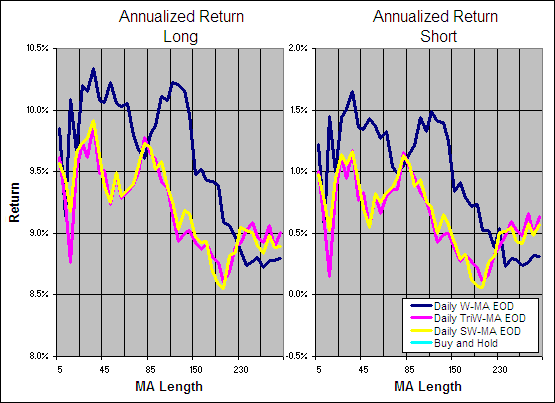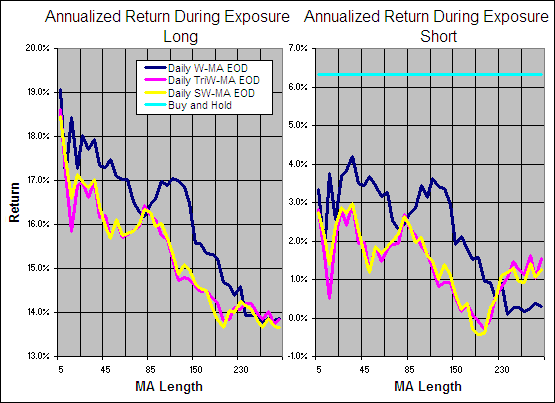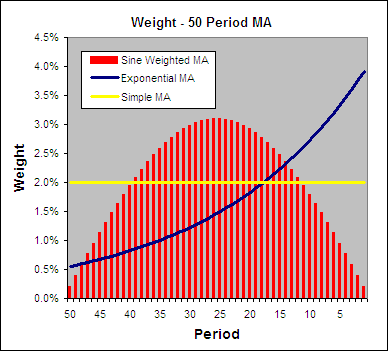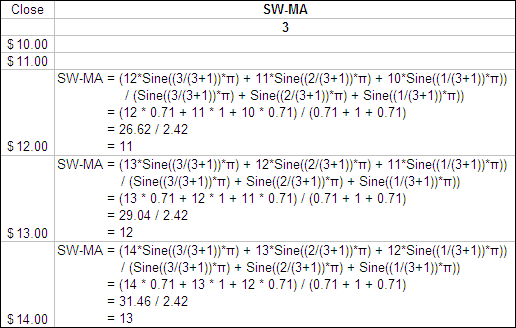A Weighted Moving Average smooths data by setting a separate but specific weighting for each data set over the length of its smoothing period. In this round of testing we will look at the standard Weighted Moving Average (W-MA), the Triangular Weighted Moving Average (TriW-MA) and the Sine Weighted Moving Average (SW-MA) in order to reveal which is the best and if any of them are worth including in your trading tool box.
To evaluate these averages we tested Long and Short trades using Daily and Weekly data, taking End Of Day (EOD) and End Of Week (EOW) signals with Moving Average lengths varying from from 5 – 300 days or 60 weeks.~ These tests were carried out over a total of 300 years of data across 16 different global indexes (details here).
.
Weighted Moving Averages – Test Results:
.
Weighted Moving Average – Test Conclusion
.

.
Above you can see how the annualized return changes with the length of each Daily, EOD Moving Average for the Long and the Short side of the market. The relative performance of each MA was similar when going Long or Short but the returns on the Short side were much lower.
There is little difference in performance between the TriW-MA and the SW-MA while the W-MA was clearly superior. The W-MA performed particularly well with a setting of 35 days or 110 days, peaking with a annualized return of over 10% on these settings. As the smoothing period is extended beyond 110 days the returns gradually diminished.
Return to Top
.

.
Above you can see the performance of each average during the time that it was exposed to the market. Across the board the efficiency of each average decreased as the length of each average is was increased. The W-MA again proved the most effective.
Return to Top
.
Best Weighted Moving Average – Long
.
We tested 357 averages on the Long side but rather than simply selecting the one with the greatest returns over the test period we looked for the following criteria:
- Annualized Return > 9%
- Average Trade Duration > 29 Days
- Annualized Return During Exposure > 15%
- Annualized Return on Nikkei 225 > 3%
- Annualized Return on NASDAQ > 12.5%
8/357 Averages made the final cut (see spreadsheet) but we selected the 90 Day Weighted Moving Average with End of Week Signals as the ultimate winner:
.

.
Above you can see how the 90 Day W-MA, EOW Long performed during the test period compared to the 75 Day EMA, EOW Long which was selected as the most effective Exponential Moving Average in a previous test. The Weighted MA produced very similar results to the EMA but didn’t offer any benefits.
Return to Top
.
Weighted Moving Average – Test Conclusion
.
The Triangular and Sine Weighted Moving Averages proved to be inferior to the W-MA while the standard Weighted Moving Average did produce reasonable returns. Those returns however, were similar (if slightly inferior) to those of an Exponential Moving Average while not offering any notable benefits. Therefore it can be concluded that none of the Weighted Moving Averages we tested are worth perusing further.
Return to Top
.
~ An entry signal to go long (or exit signal to cover a short) for each average tested was generated with a close above that average and an exit signal (or entry signal to go short) was generated on each close below that moving average. No interest was earned while in cash and no allowance has been made for transaction costs or slippage. Trades were tested using End Of Day (EOD) and End Of Week (EOW) signals for Daily data and EOW signals only for Weekly data. Eg. Daily data with an EOW signal would require the Week to finish above a Daily Moving Average to open a long or close a short and vice versa.
.
– The average annualized return of the 16 markets during the testing period was 6.32%. The data used for these tests is included in the results spreadsheet and more details about our methodology can be found here.

 .
.



